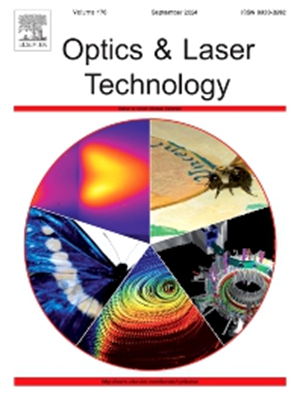High addition content WC particle reinforced titanium matrix composites fabricated by concurrent wire powder feeding laser directed energy deposition
IF 4.6
2区 物理与天体物理
Q1 OPTICS
引用次数: 0
Abstract
Concurrent wire powder feeding laser directed energy deposition (L-DED-WP) combines the advantages of both powder feeding and wire feeding laser deposition. This technique offers distinct advantages in producing composites with high addition content. A key challenge in composite fabrication methods is achieving high addition content without compromising quality or mechanical properties. This work addresses this gap by fabricating WC/Ti6Al4V composites with varying WC additions (40 wt%, 60 wt%, and 80 wt%) and analyzing their microstructure and mechanical properties. The mechanical properties of composites are influenced by the matrix, reinforcing phase, and the reaction layer. The study examines the evolution of phase composition, including W2C, WC, W, TiC, and [W, Ti]C1-X, and the effect of WC content on microstructures and tribological properties. The results show that TiC precipitation increases with higher WC content, with TiC morphology transitioning from chain eutectic to equiaxed and dendritic primary TiC. The reaction layer thickness increases from 4.12 μm to 11.76 μm as WC content increases. Increased precipitation of TiC and [W, Ti]C1-X facilitates the heterogeneous nucleation of β(Ti, W). The matrix’s β(Ti, W) is refined, reducing the texture strength. During the wear process, the un-melted WC (UMWC) particles share part of the frictional force, thereby preventing severe wear of the matrix. The composites exhibit significant improvements in tribological performance compared to Ti6Al4V, with a 53.19 % reduction in the friction coefficient and a 94.55 % decrease in wear mass loss for the 80WC/Ti6Al4V composite. This research demonstrates the potential of L-DED-WP for fabricating high performance composites with high WC content, offering a cost effective and efficient approach for aerospace applications.
通过同时送丝粉末激光定向能沉积法制造高添加量 WC 粒子增强钛基复合材料
同步送丝激光定向能沉积(l - ed - wp)结合了送粉激光沉积和送丝激光沉积的优点。该技术在生产高添加量复合材料方面具有明显的优势。复合材料制造方法的一个关键挑战是在不影响质量或机械性能的情况下实现高添加量。本研究通过制造WC/Ti6Al4V复合材料,添加不同的WC (40 wt%, 60 wt%和80 wt%),并分析其微观结构和机械性能,解决了这一差距。复合材料的力学性能受基体、增强相和反应层的影响。研究了W2C、WC、W、TiC和[W, Ti]C1-X等相组成的演变,以及WC含量对微观组织和摩擦学性能的影响。结果表明:随着WC含量的增加,TiC析出量增加,TiC形貌由链共晶向等轴和枝晶初生TiC转变;随着WC含量的增加,反应层厚度从4.12 μm增加到11.76 μm。TiC和[W, Ti]C1-X的析出增加,促进了β(Ti, W)的非均相形核,使基体的β(Ti, W)细化,降低了织构强度。在磨损过程中,未熔化WC (UMWC)颗粒分担了部分摩擦力,从而防止了基体的严重磨损。与Ti6Al4V相比,80WC/Ti6Al4V复合材料的摩擦学性能得到了显著改善,摩擦系数降低了53.19%,磨损质量损失降低了94.55%。这项研究证明了l - d - wp在制造高WC含量的高性能复合材料方面的潜力,为航空航天应用提供了一种经济高效的方法。
本文章由计算机程序翻译,如有差异,请以英文原文为准。
求助全文
约1分钟内获得全文
求助全文
来源期刊
CiteScore
8.50
自引率
10.00%
发文量
1060
审稿时长
3.4 months
期刊介绍:
Optics & Laser Technology aims to provide a vehicle for the publication of a broad range of high quality research and review papers in those fields of scientific and engineering research appertaining to the development and application of the technology of optics and lasers. Papers describing original work in these areas are submitted to rigorous refereeing prior to acceptance for publication.
The scope of Optics & Laser Technology encompasses, but is not restricted to, the following areas:
•development in all types of lasers
•developments in optoelectronic devices and photonics
•developments in new photonics and optical concepts
•developments in conventional optics, optical instruments and components
•techniques of optical metrology, including interferometry and optical fibre sensors
•LIDAR and other non-contact optical measurement techniques, including optical methods in heat and fluid flow
•applications of lasers to materials processing, optical NDT display (including holography) and optical communication
•research and development in the field of laser safety including studies of hazards resulting from the applications of lasers (laser safety, hazards of laser fume)
•developments in optical computing and optical information processing
•developments in new optical materials
•developments in new optical characterization methods and techniques
•developments in quantum optics
•developments in light assisted micro and nanofabrication methods and techniques
•developments in nanophotonics and biophotonics
•developments in imaging processing and systems

 求助内容:
求助内容: 应助结果提醒方式:
应助结果提醒方式:


